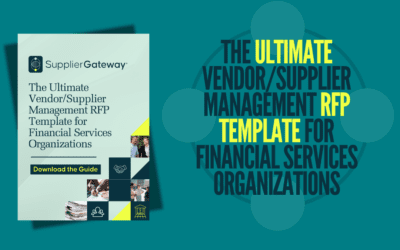Introduction
You’re tasked with developing and implementing a supplier lifecycle management (SLM) program. Congratulations! This critical initiative can significantly impact your organization’s operations.
But before you can get started, you need to understand the main aspects of supplier lifecycle management. In this article, you’ll learn about SLM and best practices for supplier onboarding and offboarding.
What Is Supplier Lifecycle Management?
Supplier lifecycle management (SLM) is the proactive oversight of supplier performance and relationships from when a supplier is onboarded to when they are offboarded. It includes all steps in the supplier relationship, from finding new suppliers to maintaining existing ones and offboarding suppliers you are no longer doing business with.
SLM is important for two reasons. First, it helps ensure a company gets the best possible value from its suppliers. Second, it helps protect the company from risk. By monitoring supplier performance and having protocols for dealing with all stages of supplier management, a company can avoid costly disruptions to its business.
Benefits of Supplier Onboarding and Offboarding
When you onboard a new supplier, you welcome them into your organization. This is an opportunity to set the tone for the relationship, establish expectations and get them up to speed on your processes and requirements.
The benefits of a smooth supplier onboarding process are clear: You reduce the risk of disruptions to your operations, ensure that they meet your quality and performance standards, and build trust for future collaborations.
Offboarding a supplier is just as important as onboarding them. When done correctly, it can minimize the risk of disruptions to your operations, protect your brand reputation and mitigate any future legal issues.
Strategies for Effective Supplier Onboarding and Offboarding
When it comes to onboarding and offboarding new suppliers, there are best practices to keep in mind:
- Automate the process when possible. Manual processes are time-intensive and inaccurate. According to Informatica, businesses that automate part or most of their supplier onboarding processes spend up to 80% less time onboarding new suppliers. Automation allows for greater accuracy and efficiency when gathering critical supplier information or identifying suppliers for offboarding. You can maximize onboarding efficiency by establishing a self-service portal where suppliers can enter their own data. Identifying suppliers eligible for offboarding can also be automated based on specific criteria.
- Be consistent in your approach. Onboarding and offboarding aren’t just for procurement. Processes should be consistent company-wide. Utilizing the same supplier onboarding software regardless of department helps establish a single source of supplier information. Receiving alerts when a supplier should be offboarded helps ensure consistent risk mitigation practices.
- Be serious about due diligence. Spend adequate time with the supplier selection process, especially when choosing suppliers critical to your business. This can ultimately save time by eliminating unfit suppliers from your selection pool. Pay particular attention to data security practices, reputational risk, financial information and risk, and insurance information. When offboarding suppliers, revoke access to company systems, data, and physical spaces if applicable.
- Get leadership buy-in ASAP. Leadership buy-in early on is essential when creating a supplier onboarding and offboarding process for company-wide use. Make sure all necessary stakeholders are involved. Leadership buy-in ensures that your entire organization uses and understands the SLM process, which drives the success of an onboarding and offboarding program.
Strategies for Successful Supplier Offboarding
Supplier lifecycle management doesn’t end after a supplier onboards. Your company needs a defined process for ending supplier relationships that is graceful and mitigates risk.
A clear roadmap is essential for both parties during the supplier offboarding process. This roadmap should include steps such as providing notification of termination, establishing an exit timeline, determining transition responsibilities, and more.
Document the entire process between the buyer and supplier. Documentation helps mitigate unforeseen legal and reputational risks for your business. It also establishes expectations and ensures that both parties have fulfilled all contractual obligations before the relationship ends.
By setting up a well-defined plan during offboarding, you can help build healthy relationships with your suppliers even after they are no longer active partners.
Automating the Supplier Lifecycle Process
Supplier lifecycle management isn’t something you can do quickly and easily, but automating your supplier lifecycle process can help simplify onboarding while ensuring the safety and security of your supplier relationship. Automation also reduces manual data entry and prevents costly errors.
At SupplierGateway, we’re experts in automating the supplier lifecycle process, allowing your team to focus on other tasks. Our software streamlines onboarding through custom workflows based on supplier type, and automatically checks for supplier data correctness through over 300 databases.
Our automated system does the heavy lifting for compliance. Our platform automatically notifies buyers and suppliers about supplier compliance and audit requirements and tracks their compliance status. Automation ensures that your vendors remain compliant with all relevant regulations and laws throughout their lifecycle with your organization.
The Impact of Supplier Lifecycle Management on Your Business
Supplier lifecycle management can have a significant impact on your business. But how exactly? Depending on the size and complexity of your supply chain, you could be looking at lower costs, improved supplier relationships, and increased quality and innovation.
With a strong SLM strategy in place, you can minimize the time spent evaluating and onboarding new suppliers while maximizing the quality of those suppliers. You can also improve visibility into your current suppliers’ performance, allowing you to quickly identify areas that need improvement or high-risk suppliers to avoid.
Plus, with the supplier lifecycle management tools in SupplierGateway’s Enterprise Supplier Master Data Management Platform that make onboarding and offboarding smoother and more efficient, you can quickly identify any areas of opportunity. With the right supplier lifecycle management processes, you can save time and money and reduce risk while ensuring a better relationship between you and your suppliers.
Conclusion
Regarding supplier management, it’s essential to have a process for onboarding and offboarding suppliers. These processes help your company get the best products and services from your suppliers while maintaining good relationships during the contract. Offboarding suppliers you’re no longer doing business with ties up loose ends and protects your company from unknown risk factors.
To learn more about SupplierGateway’s onboarding and offboarding solutions, get in touch and schedule your demo.











